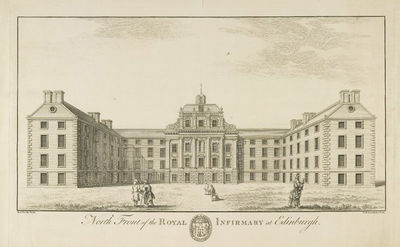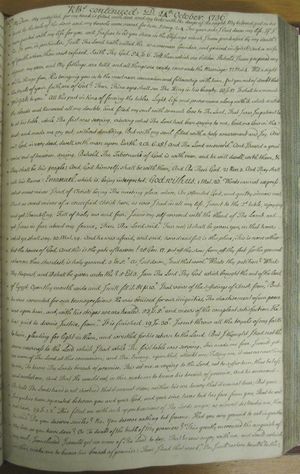George Drummond (1688-1766)

George Drummond (1688-1766), served as Lord Provost of Edinburgh six times between 1725 and 1764. He played a vital role in the Foundation of the Faculty of Medicine and in turning the 'Tounis College' into an Enlightenment university.
Early Life
The son of an Edinburgh merchant, Drummond was educated in the city’s Royal High School from 1699 to 1704, where he excelled in arithmetic. Aged only eighteen, he was employed by a committee of the Scottish Parliament charged with settling national accounts before the 1707 Union with England. Following Union, he was appointed to the post of Accountant-General of Excise in Edinburgh, and, in 1717, was selected as one of the Commissioners of Customs.
Drummond was passionately devoted to the Union cause and to the House of Hanover. In 1715 he took up arms and fought at the Battle of Sheriffmuir, which halted the Jacobite army's march upon the capital. His loyalty to the government led to his election to the Town Council of Edinburgh in 1716. Drummond was made City Treasurer in 1717 and Dean of Guild in 1722 (in which capacity he approved all building work undertaken in Edinburgh). Finally, in 1725 he was elected Lord Provost for the first time.
First Period as Lord Provost (1725-1727)
Even before his election, Drummond had shown a particular interest in University affairs and a strong commitment to carrying through the programme of reforms initiated by William Carstares (1649-1715), the Principal of Edinburgh University from 1703 to 1715. In partnership with John Monro (d. 1740), Deacon of the Incorporation of Surgeons, Drummond aimed to create a medical school at Edinburgh University on the model of Dutch universities such as Leiden. He was first instrumental, as a leading member of the Town Council, in having Monro’s son Alexander Monro ''primus'' (1697-1767) elected to the Chair of Anatomy in 1720, founding a three-generation dynasty that held the position until the mid-19th century. Next, as Lord Provost in 1726, Drummond oversaw the Foundation of the Faculty of Medicine. In addition to the existing Chair of Anatomy, an Act of the Town Council of Edinburgh created two professorships of the Theory and Practice of Medicine and two professorships of Medicine and Chemistry. The Act further granted Edinburgh University the power to instruct and to examine for itself candidates for the degree of medicine.
Drummond and Alexander Monro also saw the necessity of creating a teaching hospital if the new Medical School was to thrive. They were the driving force behind the establishment of the Royal Infirmary of Edinburgh, organizing a subscription which finally led to its opening in purpose-built premises in 1741. By Drummond’s death, the Faculty of Medicine was not only the centre for Scottish medical learning, but was attracting students from England and abroad. Its success lay the foundation for Edinburgh University’s international reputation.
Drummond and the '45
The 1730s saw a temporary waning of Drummond’s influence over Edinburgh affairs. He fell foul of Archibald Campbell (1682-1761), Earl of Ilay, the dominant figure in Scottish politics, after repeatedly failing to consult him when appointing new office-holders in his capacity as Commissioner of Customs. In 1737, Ilay first threatened Drummond with dismissal then demoted him to the Board of Excise. Eight years later, the Jacobite Rebellion of 1745 propelled Drummond back into the limelight. Once again, he showed his devotion to the Hanoverian cause, serving as Captain to the College Company of university volunteers that were formed to defend Edinburgh against Charles Edward Stuart’s army. On 15 September, he proposed marching the College Company out of Edinburgh to confront the approaching Jacobite Army, and was only dissuaded by the intervention of William Wishart "secundus" (c1692-1753), then Principal of Edinburgh University. Interpretations of Drummond’s behaviour in this episode differ. For some volunteers, like John Home (1722-1808), Drummond was making a parade of patriotic zeal for his own political advantage and never intended to face the rebels. For others, like Alexander Carlyle (1722-1805), he was genuinely conscience-stricken at the thought of sending young men to a futile death. Drummond’s personal courage appears to be beyond question. He joined Sir John Cope’s Hanoverian army before the Battle of Prestonpans and was exiled from Edinburgh throughout the Jacobite occupation. Drummond’s loyalty was again rewarded, as he was elected Lord Provost for a second time in 1746. (See The University and the '45 for more details.)
Second Period as Lord Provost (1746-1764)

Between 1746 and 1764, Drummond held the office of Lord Provost five times. Throughout this period he strove to align Edinburgh University with the burgeoning Enlightenment culture of the capital, by promoting leading members of the moderate clergy to professorial chairs. He played a major role in the appointments of Adam Ferguson (1723-1816) as Professor of Natural Philosophy (1759), Hugh Blair (1718-1800) as Regius Chair of Rhetoric and Belles Lettres (1760) and, finally, William Robertson (1721-1793) as Principal in 1762.
Drummond’s commitment to modernizing the University was part of a wider scheme of civic improvement. Proposals, signed by Drummond as Lord Provost were circulated throughout Scotland, calling on all Scotsmen to contribute to the improvement of the capital. These included the building of a Royal Exchange, City Chambers, new Courts of Justice, and the expansion of Edinburgh to both north and south. Many of these reforms were only seen through after Drummond’s death, but he lived to see the completion of the Royal Exchange (1760) and to lay the cornerstone of the North Bridge (1763).
Drummond died on 4 September 1766. The funeral procession which attended his coffin on 8 December included Principal William Robertson and all the professors of the University.
Judgements on Drummond
The University’s historians have unanimously acknowledged Drummond as a major force in turning the Tounis College into a modern university. Sir Alexander Grant (1826-1884) describes him as the 'wisest and best disposed of all the long list of Town Councillors and Provosts, who during 275 years acted as patrons of the College or University'.
Alexander Bower (fl. 1804-1830) writes:
That he was the greatest benefactor which the University ever had, will not be called in question by those who are acquainted with his history. From the year 1715 to the time of his death in 1766, nothing was done in the College without his advice or direction. His care of the University not only extended to an accurate investigation how its funds were expended, but he was of much more essential service in procuring men of real talents to be appointed as Professors. In the course of the fifty years during which he managed the city, he may be said to have appointed all the Professors.
Archives
Sources
- Robert D. Anderson, 'The Construction of a Modern University', in Robert D. Anderson, Michael Lynch, and Nicholas Phillipson, The University of Edinburgh: An Illustrated History (Edinburgh: Edinburgh University Press, 2003), pp. 103-207.
- Alexander Bower, The History of the University of Edinburgh. 3 vols. Edinburgh, 1817-1830.*Alexander Carlyle, Autobiography of the Rev. Dr. Alexander Carlyle, Minister of Inveresk: Containing Memorials of the Men and Events of his Time (Edinburgh: W. Blackwood, 1860)
- Andrew Dalzel, History of the University of Edinburgh from its Foundation, 2 vols (Edinburgh: Edmonston and Douglas, 1862)
- Sir Alexander Grant, The Story of the University of Edinburgh during its First Three Hundred Years, 2 vols (London: Longmans, Green, and Co., 1884)
- John Home, The History of the Rebellion in the Year 1745 (London: T. Cadell, Jun. and W. Davies, 1802)
- David Bayne Horn, A Short History of the University of Edinburgh, 1556-1889 (Edinburgh: Edinburgh University Press, 1967)
- Alexander Murdoch, 'Drummond, George (1687–1766)', Oxford Dictionary of National Biography (Oxford: Oxford University Press, 2004) [[1], accessed 24 June 2014]